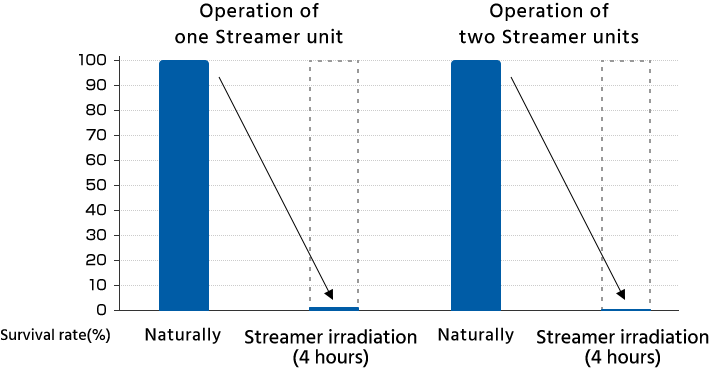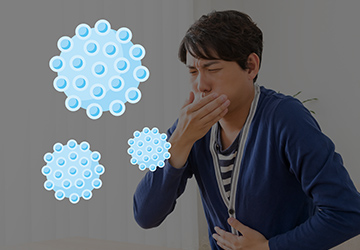It has been proved that the active elements produced by the Streamer technology decomposes and neutralizes the norovirus by contacting the norovirus that causes food poisoning. Furthermore, this time, it was proved that operating two Streamer units doubled the suppression effect.

Department of Biomedical Science,
Graduate School of Agriculture and Life Science,
the University of Tokyo
- This is the demonstration result using a streamer discharge device for testing.
- The effect of products equipped with Streamer technology or the effect in actual use environment may differ.
Demonstration of the suppression effect against norovirus

The survival rate of norovirus after 4 hours of Streamer irradiation was 0.6% for two units operation compared to 1.3% for one unit operation, confirming approximately twice the suppression effect.
- This is the demonstration result using a streamer discharge device for testing.
- The effect of products equipped with Streamer technology or the effect in actual use environment may differ.
Testing organization
Department of Biomedical Science, Graduate School of Agriculture and Life Science, the University of Tokyo
Test method
Use mouse norovirus [Mouse norovirus] (1) Virus belonging to the genus Calicivirus Norovirus (single-stranded RNA virus, plus sense, no envelope). (2) A related virus that belongs to the same virus genus as human norovirus and may be used as a substitute for human norovirus. (3) Increase in mouse macrophage-like tumor cell line RAW264 cells. The MNV-S7 strain (Genbank accession no. AB435515, Toya etc.) used in this experiment was expanded with the above RAW264 cells (purchased from RIKEN BRC Cell Bank). D-MEM/Ham's F-12 (containing phenol red, HEPES, sodium pyruvate) was used as the culture solution. The virus titer was determined by the TDIDT50 method using a 96-well plate.
Be cautious for norovirus in winter!

Bacterial food poisoning is more common in the summer, when fungi are more prone to growth, but since viruses prefer low temperatures and dry environments, viral food poisoning increases in winter. Among them, the overwhelming majority are food poisoning due to norovirus. Norovirus is extremely infectious and often spreads at a stretch, resulting in more outbreaks and patients than in the summer. Looking at the number of food poisoning patients per year, norovirus accounts for more than half of them.

